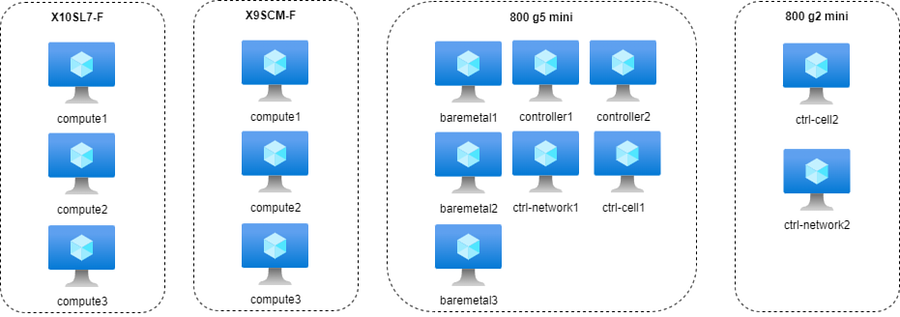Lab architecture
Sauter à la navigation
Sauter à la recherche
One region, two availability zones
This Openstack Lab is composed of one region (fr1) and two availability zones (az1 and az2).
In the first availability zone :
- 3 compute nodes (aka hypervisors) for Nova wihtin a Nova Cell called cell1
- 1 Ceph cluster for Cinder and Glance
- 3 bare metal nodes for Ironic
In the second availability zone :
- 3 compute nodes wihtin a Nova Cell called cell2
- 1 Ceph cluster (Cinder only)
Networks
The different networks are :
- fr1-az1 : provider network in AZ1 (flat, i.e. without VLAN, shared, i.e. available for everybody and external, i.e. managed outside Openstack)
- fr1-az2 : provider network in AZ2
- ironic : external VLAN for bare metal nodes (only available in AZ1)
- octavia : external VLAN for Octavia management (only available in AZ1)
Resources
- Availability Zone 1 :
- HP Elitedesk 800 g5 mini (Intel Core i5-9500, 64 GB RAM DDR4, 500 GB NVME)
- 3 VMs acting as baremetal nodes (1 vCPU, 4 GB RAM, 20 GB disk for each VM)
- 2 VMs for Openstack controllers (2 vCPUs, 16 GB RAM, 40 GB disk for each VM)
- 1 VM for Openstack cell controller (1 vCPU, 2 GB RAM, 20 GB disk)
- 1 VM for Openstack network controller (1 vCPU, 2 GB RAM, 20 GB disk)
- Supermicro X9SCM-F (Intel Xeon E3-1265L v2, 32 GB RAM ECC DDR3)
- 3 VMs acting as hyperconverged nodes (compute + Ceph RBD storage). Each VM has 10 GB of RAM, 2 vCPUs, one virtual disk for OS and one virtual disk for Ceph OSD
- HP Elitedesk 800 g5 mini (Intel Core i5-9500, 64 GB RAM DDR4, 500 GB NVME)
- Availability Zone 2:
- HP Elitedesk 800 g2 mini (Intel Core i5-6500T, 32 GB RAM DDR4, 500 GB NVME)
- 1 VM for Openstack cell controller (1 vCPU, 2 GB RAM, 20 GB disk)
- 1 VM for Openstack network controller (1 vCPU, 2 GB RAM, 20 GB disk)
- Supermicro X10SL7-F (Intel Xeon E3-1265L v3, 32 GB RAM ECC DDR3)
- 3 VMs acting as hyperconverged nodes (compute + Ceph RBD storage). Each VM has 10 GB of RAM, 2 vCPUs, one virtual disk for OS and one virtual disk for Ceph OSD
- HP Elitedesk 800 g2 mini (Intel Core i5-6500T, 32 GB RAM DDR4, 500 GB NVME)
The bare metal nodes are "simulated" thanks to Virtual BMC and Sushy-tools. Ironic uses among others the IPMI or Redfish protocol to turn on/off/change the boot order of nodes.



